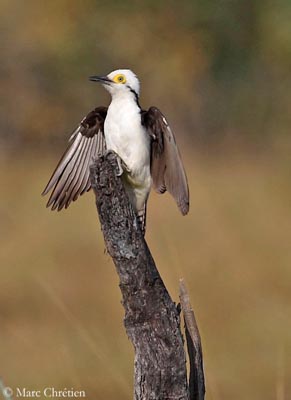
Fr: Pic dominicain
All : Weißspecht
Esp : Carpintero Blanco
Ital: Picchio bianco
Nd: Witte Specht
Sd: Vitspett
Photographers:
Marc Chrétien
MURINUS
Philippe et Aline Wolfer
OISEAUX D’ARGENTINE
Text by Nicole Bouglouan
Sources:
HANDBOOK OF THE BIRDS OF THE WORLD Vol. 7 by Josep del Hoyo-Andrew Elliott-Jordi Sargatal – Lynx Edicions – ISBN: 8487334377
L’ENCYCLOPEDIE MONDIALE DES OISEAUX - Dr Christopher M. Perrins - BORDAS - ISBN: 2040185607
Arthur Grosset's Birds (Arthur Grosset)
BirdLife International (BirdLife International)
Wikipedia, the free encyclopaedia
White Woodpecker
Melanerpes candidus
Piciforme Order – Picidae Family
BIOMETRICS:
Length: 24-29 cm
Weight: 98-136 g
DESCRIPTION:
The White Woodpecker is a very distinctive woodpecker of South America, often seen in small noisy groups.
The adult male has black mantle and upperback. On the upperwing, the flight feathers are brownish-black. Wing-coverts and tertials are black, slightly glossed blue. The lower back is white to the uppertail-coverts. The uppertail is brownish-black with white base. The outer rectrices show white spots.
Underparts are white to creamy-white, slightly washed buff, sometimes darker. We can see a yellow patch on the lower belly, sometimes reaching the lower breast. The underwing is greyish-brown with black coverts.

The head is white and shows a blackish loral line and a narrow black stripe from the lower rear of the eye and curving down to the uppermantle. On the lower hindneck, some longer feathers are pale lemon-yellow.
The strong, straight bill is fairly long and chisel-tipped. It is black with paler base, greenish or whitish. The eyes are white, pale bluish-white or yellow. They are surrounded by a broad, golden-yellow eye-ring. Legs and feet are greyish or brownish.
The female has similar plumage, but she lacks the yellow feathers on the hindneck, and the black head stripe is often duller than in male.
The juvenile is rather dark brown than black, with less glossy plumage. The white areas are tinged buff, and the yellow patch on belly is duller. The eyes are grey with bluish eye-ring.
The young male has the yellow head feathers extending from the nape to the crown, whereas the young female has broken yellow band on the nape.
VOICE: SOUNDS BY XENO-CANTO
The White Woodpecker utters some “ghirrch” or “kreer” when perched. This is its common call, making it unmistakable.
When in flight, it gives distinctive “kirr-kirr-kirr” or “cree-cree-cree-creek” similar to tern’s calls.
HABITAT:
The White Woodpecker frequents dry subtropical forests, woodlands, savannahs with some trees, open wooded areas and dry scrub.
This woodpecker is often seen at forest edges and in cultivated fields. It often frequents palm groves and orchards, and also exotic plantations.
It is visible mainly in lowlands, but locally up to 2000-2200 metres of elevation.
RANGE:
The White Woodpecker is found from extreme south Peru, S Mato Grosso and NE Brazil, S to E Bolivia, N Argentina, and W and S Uruguay.

BEHAVIOUR:
The White Woodpecker is mainly fructivorous, but it also consumes seeds, honey, and insects. It also catches wasps and bees, and especially the Irapuá Bee (Melipona ruficrus) which is a pest of citrus growers, widespread in the warm areas of the Neotropics, from Mexico to Argentina. The bird opens the nests of wasps and bees, takes the grubs and the honey, while performing aerial flycatching.
The White Woodpecker usually occurs in small noisy groups of 5-8 birds, sometimes with other species of the genus Colaptes. These small flocks are considered as pests by farmers, because they damage numerous fruits in orchards.
To form groups occurs mainly in Melanerpes species which are fructivorous. Several individuals join their efforts to find fruiting trees, and this habit of flocking also reduces the predation.
This arboreal species forages by pecking and gleaning, and can catch insects on the wing.

During the breeding season, all the birds of the group take part in displays. They perform numerous flight displays and frequent bowing and bobbing. They hop on a branch while climbing with raised, flapping wings, flying from a branch to another and then, returning to the first. The head feathers are puffed up during the displays.
These birds occur together in localized clusters, feeding and flying in groups, and they naturally continue together and breed communally.
The White Woodpecker seems to be resident in its range, with possible wandering birds.
FLIGHT:
The White Woodpecker is able to fly long distances over open areas, and high in the air. The flight is relatively straight (and non-undulating as in most woodpeckers).
It alights in trees for foraging and flies again to another. It may perform flycatching when feeding in front of the nests of wasps and bees.

REPRODUCTION:
The breeding season occurs in September-November. The reproduction of the White Woodpecker is poorly known.
They probably breed communally in groups of 5-8 birds. The nest is a hole in tree or stump, but they could use holes among rocks too.
The female lays 3-4 white eggs. The incubation is shared by both parents, but its duration is unknown.
The young fledge about 35 days after hatching.
DIET:
The White Woodpecker feeds primarily on fruits. They live in small groups and damage the orchards. When they drop into a fruiting tree, they are often compared to parrots arriving at rich food sources.
They also consume seeds and honey. They open wasps and bees’ nests, and take honey and larvae. They also catch other insects, even in flight.

PROTECTION/THREATS/STATUS:
The White Woodpecker is not threatened at this moment, and occurs in several protected areas and national parks or biological reserves in Brazil. The breeding areas seem to be expanding in the southern parts of the range.
This species is sometimes persecuted because these birds cause damages in orchards and fruit plantations. It can be trapped for cage-bird trade in Buenos Aires area.